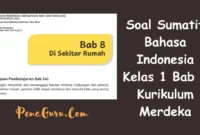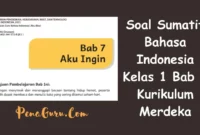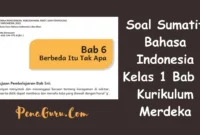Contoh soal narrative text legend dan jawabannya – Salah satu contoh narrative text adalah teks legenda. Selain itu masih banyak contoh lainnya seperti dongeng dan cerita rakyat. Namun pada kesempatan ini, sobat Penaguru akan membagikan contoh soal narrative text terkait dengan text legend beserta jawabannya.
Contoh soal narrative text kelas 10 dan 12 SMA ini dapat juga menjadi rujukan pembelajaran narrative text kelas 9 SMP. Bagaimanapun juga secara garis besar semua materi narrative text hampir sama baik SMP maupun SMA.
Silahkan simak contoh soal narrative text legend dan jawabannya yang akan kami bagikan berikut ini.
Contoh Soal Narrative Text Legend dan Jawabannya
Memang banyak situs yang menyediakan contoh soal narrative text, namun tentunya peserta didik juga memerlukan pembaharuan soal. Selain itu, keunggulan contoh soal narrative text legend dan jawabannya yang kami tawarkan adalah adanya petunjuk dan penjelasan masing-masing soal.
1. Identify the description of moral value in a folklore. Moral value is …
A. the price of a folklore after publication
B. the positive message that the texts tries to say to the reader
C. the value of a folklore among the other stories
D. the morality of the characters in the story
E. the behaviour of the main character
Clue:
Moral value aims at giving good impact to the reader’s behavior.
Penjelasan:
Moral value is wisdom or advice which people can learn from the story. Advice and wisdom has similar meaning with positive message. The word ‘value’ does not refer to price. Moral value covers the whole aspect of the story, not just for certain character.
Read the following text for number 2 – 3!
2. Read the example of folklore ‘The legend of Lake Toba’, state the reason of Batara Guru’s Anger . Batara Guru was angry because …
A. he yelled at his daughters
B. he met a beautiful girl
C. his daughters finished all of his food
D. the earth cracked
E. Batara Guru broke his promise
Clue:
Pay attention to the cause and effect. the question asks about the reason, not the effect of Batara Guru’s anger.
Penjelasan:
Yelling at his daughter was not the reason. It was the reaction of Batar Guru. Batara Guru’s breaking his promise did not make Batara Guru angry, but made his wife angry. Batara Guru was angry because his daughters ate all the lunch.
3. According to the legend of Lake Toba, the lake was created because ….
A. The earth cracked and the mountain exploded because Batara Guru’s wife was very angry.
B. Batara Guru was angry to his daughter and the mountain exploded.
C. Batara Guru married to a fish.
D. The earth cracked because Batara guru was angry to his daughters.
E. Batara Guru broke his promise.
Clue:
Pay attention to the event which happened before the creation of Lake Toba. Decide the direct cause of the creation.
Penjelasan:
Pay attention to the last part of the story. Lake Toba was created because of the earth cracked and the mountain exploded. This event is the direct cause of the creation of Lake Toba. It also means that Lake Toba was created right after the earth cracked and the mountain exploded.
4. Analyze the jumbled sequences of The Legend of Lake Toba Below, and arrange it to the correct order.
A. 1 – 2 – 3 – 4 – 5
B. 1 – 2 – 4- 3 – 5
C. 4 – 2 – 3 – 5 – 1
D. 1 – 2 – 3 – 5 – 4
E. 4 – 3 – 2 – 5 – 1
Clue:
Pay attention to the beginning and the ending of the story. Pay attention also to the order or sequence of Batara Guru’s being angry to his daughter and his marriage.
Penjelasan:
The story began with Batara Guru’s meeting with beautiful woman and ended with the creation of Lake Toba. Thus the option that begins with 1 and ends with 5 are incorrect. Batara Guru was angry at his daughter after he had married with the woman.
5. Identify the description of a folklore and explain the characteristics of a folklore. A folklore …
A. was passed down mostly in form of books
B. talks about general or international story
C. usually has moral value that is good for the readers
D. is not a history of places
E. can always predict the future
Clue:
Focus on what the story of Malin Kundang and Lake Toba try to say to the readers. Focus on what is the wisdom of the story.
Penjelasan:
A folklore usually has moral value. For example, the story of Malin Kundang advise the readers to respect their parents and the legend of Lake Toba sends us a message that we should not break our promise. A folklore was passed down mostly verbally or orally. A folklore is about a history of a place in one particular region.
6. Explain why can the story of Malin Kundang be categorized as a folklore. The story of Malin Kundang ….
A. happened in the past
B. is about curses and punishments for someone who did bad things
C. is not an international story
D. does not have happy ending
E. is really popular in western countries
Clue:
List all the features of a folklore and analyze the option one by one. Pay attention to negative statement or a statement that contains ‘not’ in the option.
Penjelasan:
The story of Malin Kundang comes originally from West Sumatera. Although now the story may be popular throughout Indonesia, it is still originated from certain area or region. A folklore can have a happy ending.
Read the following text for number 7 – 8!
7. In the beginning of the story, it was told that the boy did the prank because ….
A. He wanted to have a company.
B. He wanted to deceive the farmers.
C. There was a real wolf coming from the forest.
D. He did not like the farmers.
E. He wanted to work with the farmers in the valley.
Clue:
Why did the boy do the prank? What is his reason for doing that?
Penjelasan:
The boy felt so lonely since there was no one he could talk to. When he saw the farmers who were working in the valley, an idea crossed his mind. So, he did the prank in order to catch the farmers’ attention. In that way, he would have a company. He would have someone to talk to.
8. When the farmers came to save the boy from the wolf, they found out that ….
A. The boy was lying
B. The wolf had eaten the sheep
C. The boy was wounded
D. The wolf has gone
E. The boy was crying
Clue:
According to the story, what did happen when the farmers ran to the boy to save him from the wolf?
Penjelasan:
The boy cried, “Wolf! Wolf!” so the farmers ran from the valley to help the boy. They thought that the boy was chased by the wolf. However, when they came, they found out that there was no wolf. The boy tricked them. He was lying.
Read the following text for number 9 – 10!
9. From the story, we know that ….
A. The farmer wanted to throw the eggs away, but he changed his mind.
B. The farmer became rich because he sold the goose.
C. The goose laid a golden egg every year.
D. The goose flew away from the farm because it wanted to be free.
E. In the end, the farmer killed the goose.
Clue:
Read the text carefully, which statement is true based on the story?
Penjelasan:
The farmer was surprised to see the yellow, shiny egg in his goose nest. At first, he was about to throw it away because he thought that someone was tricked him. However, he changed his mind and take it home (the first paragraph).
10. The moral value of the story is ….
A. Be grateful for what we already have and be patient if we want something. Do not be greedy, or else we will ended up losing it all.
B. Killing animals is not a good thing. We have to take care of them.
C. We have to take care of the things that we have. Do not let them get away or you will end up regretting it.
D. Do not ever betray someone we trust, or we will end up losing them.
E. If you want to be rich, you just need to wait for a goose to lay a golden egg.
Clue:
What do we get after reading the story? What lesson can be learned from it?
Penjelasan:
The story tells us about the farmer who was very greedy. Even though he had become rich from the golden eggs that he sold, he still wanted more. He became impatient and wanted to take it all at once. At the end, he lost it all. So, the moral value of the story is that we have to be patient and do not be greedy.
Akhir Kata
Demikian contoh soal narrative text legend dan jawabannya yang dapat kami bagikan. Semoga bermanfaat buat pembelajaran narrative text. Nantikan contoh soal Bahasa Inggris selanjutnya di Penaguru.Com!



